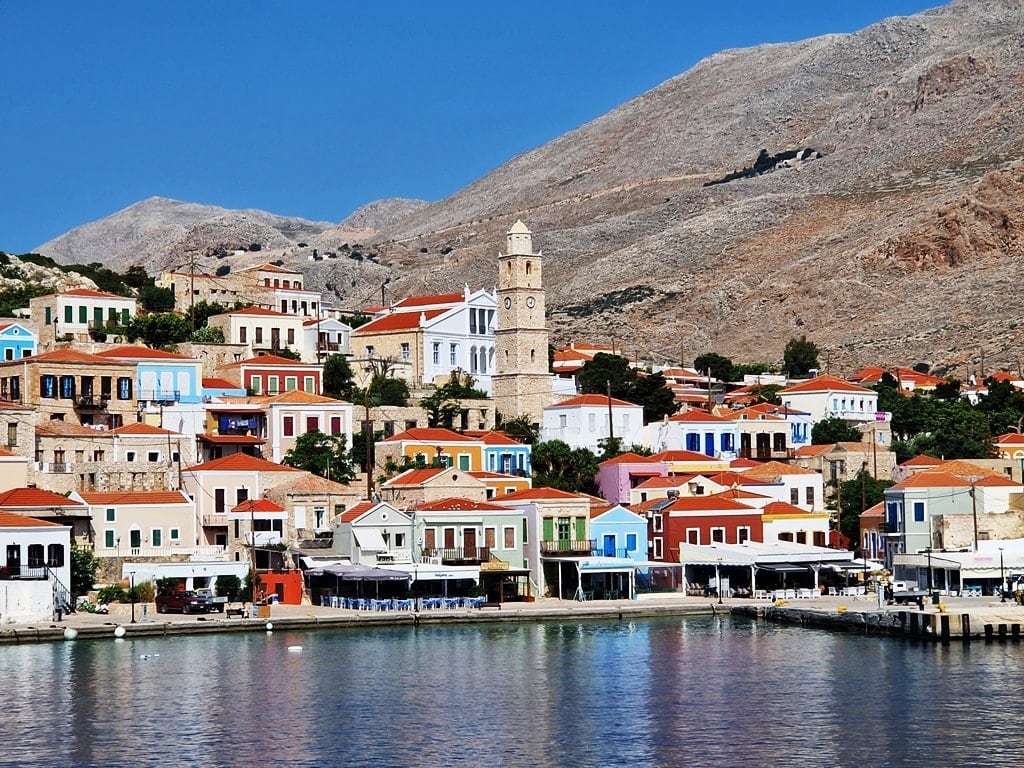If you’re looking for a touch of paradise where you can immerse yourself in relaxing beauty, then the gorgeous, tiny island of Halki is for you. This tiny jewel of the Dodecanese Islands is situated extremely close to Rhodes, for when you want a change of pace.
At Halki, you will enjoy crystal clear waters, a single beautiful village, lush nature, and enough history to make your visit unique. The moment you step onto the shores of this beautiful island, you will feel yourself unwinding, laying down the burden of routine, work, and everyday life.
Recharge as you lounge on the stunning secluded beaches of Halki, the island of Peace and Friendship, see unique sites, and enjoy good hospitality. To make the most of Halki, read on to find out everything you need to know in this concise guide.
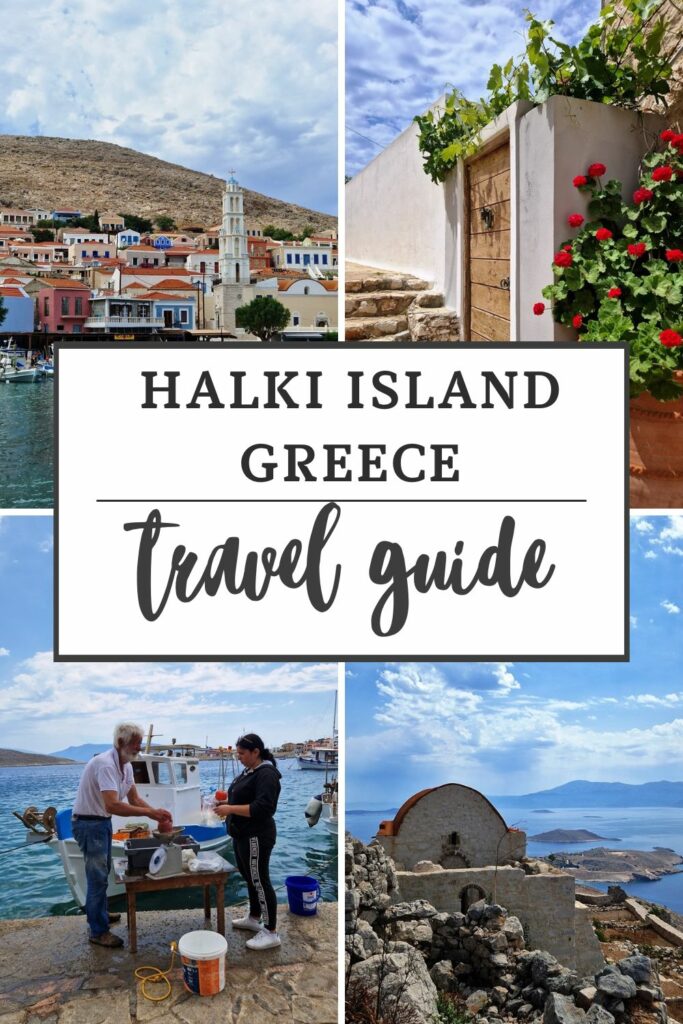
Disclaimer: This post contains affiliate links. This means that should you click on certain links, and then subsequently purchase a product, I will receive a small commission.
Where is Halki?
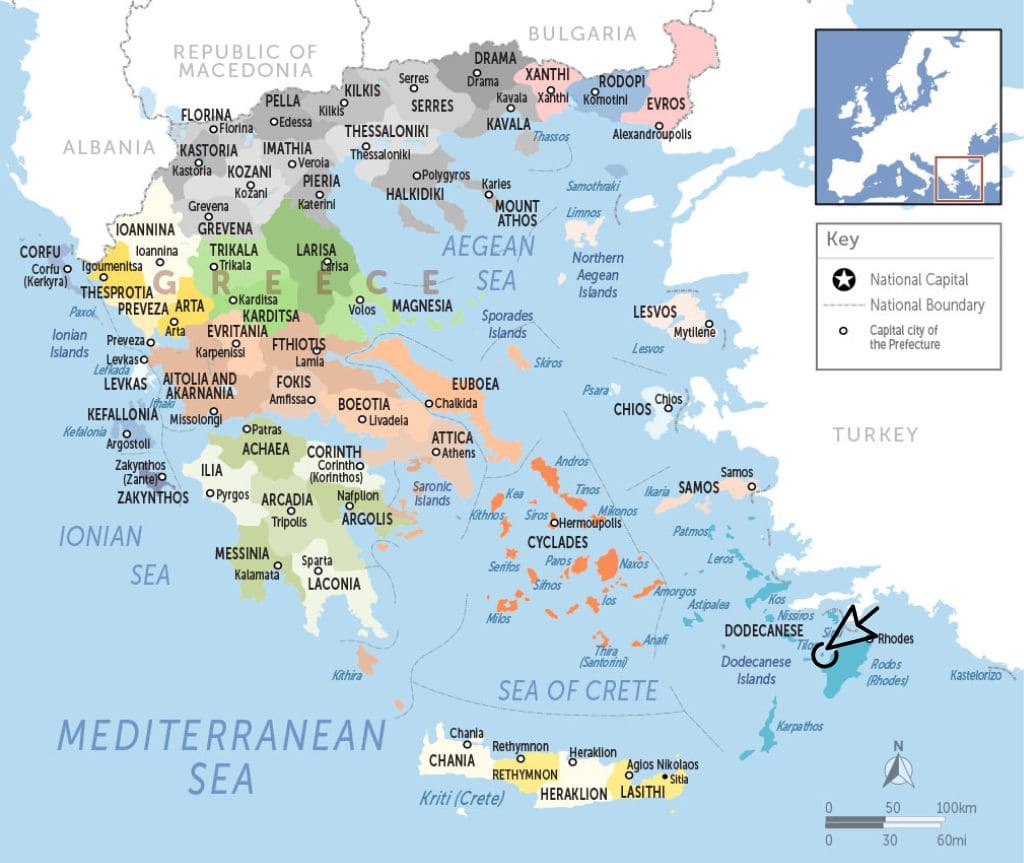
Halki is the smallest inhabited island of the Dodecanese, located just 9 km west of Rhodes. Just like Rhodes, Halki is also quite close to the Turkish coast, not more than two hours away.
The population at Halki is just 330 people and there is only a single inhabited village. Halki has a combination of green, shaded areas and arid, wild, wind-sculpted slopes.
The waters on the various beaches tend to be emerald or turquoise.
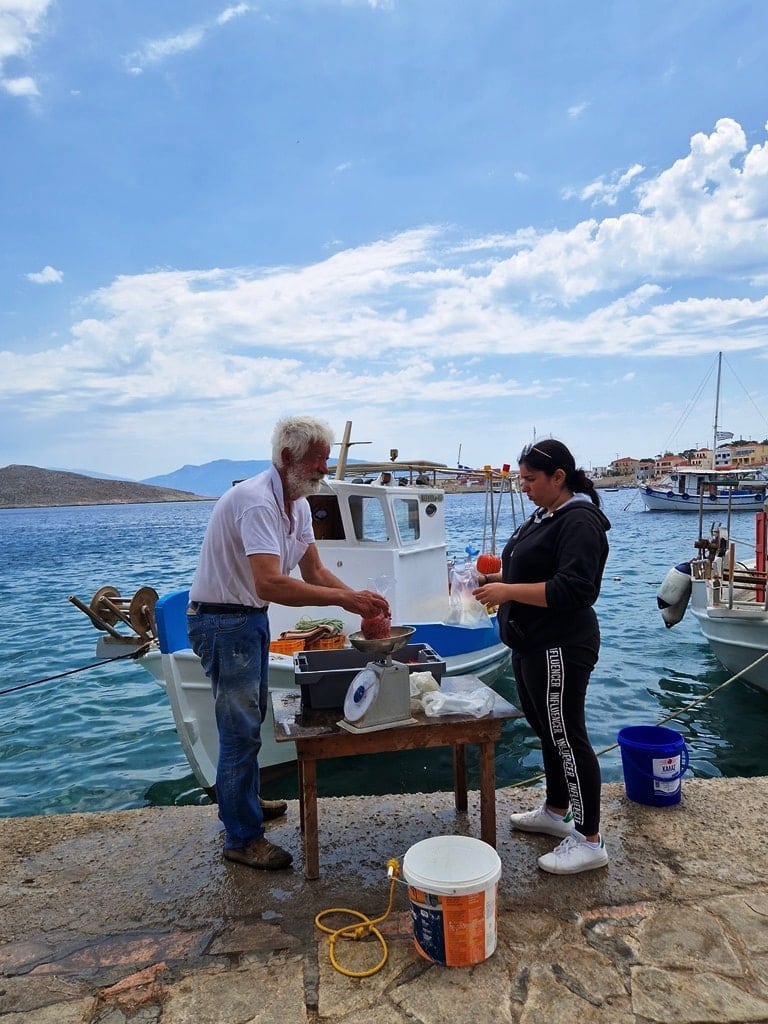
Halki’s climate is Mediterranean, like all of Greece. This means hot, dry summers and relatively mild, humid winters.
Temperatures at Halki can climb to 35 degrees Celsius during the summer (with heat waves pushing that to 40 degrees) and drop to 5 degrees Celsius during the winter. The sense of the heat, however, is mitigated by the cool waters of the sea through the sun remains relentless.
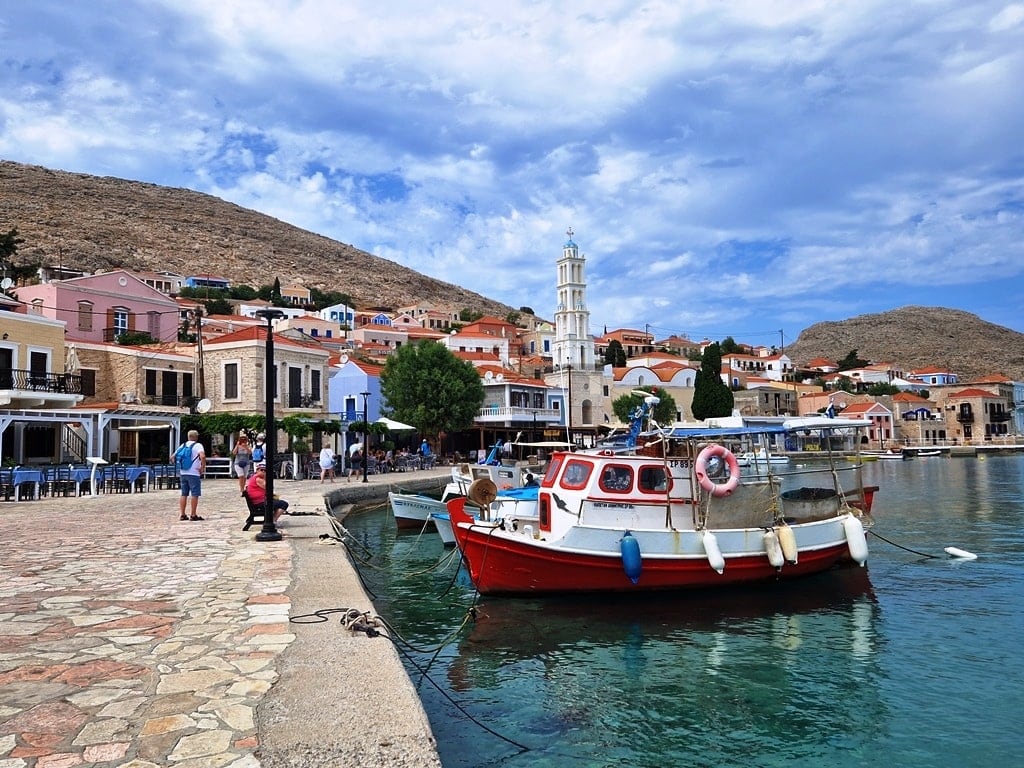
The best time to visit Halki is from mid-May to late September, which is the summer season. If you’re looking for the special cultural beat that exists on the island, you want to book your vacation for September, when the various festivals mostly take place. For warm waters, opt for mid-July to late September.
How to get to Halki
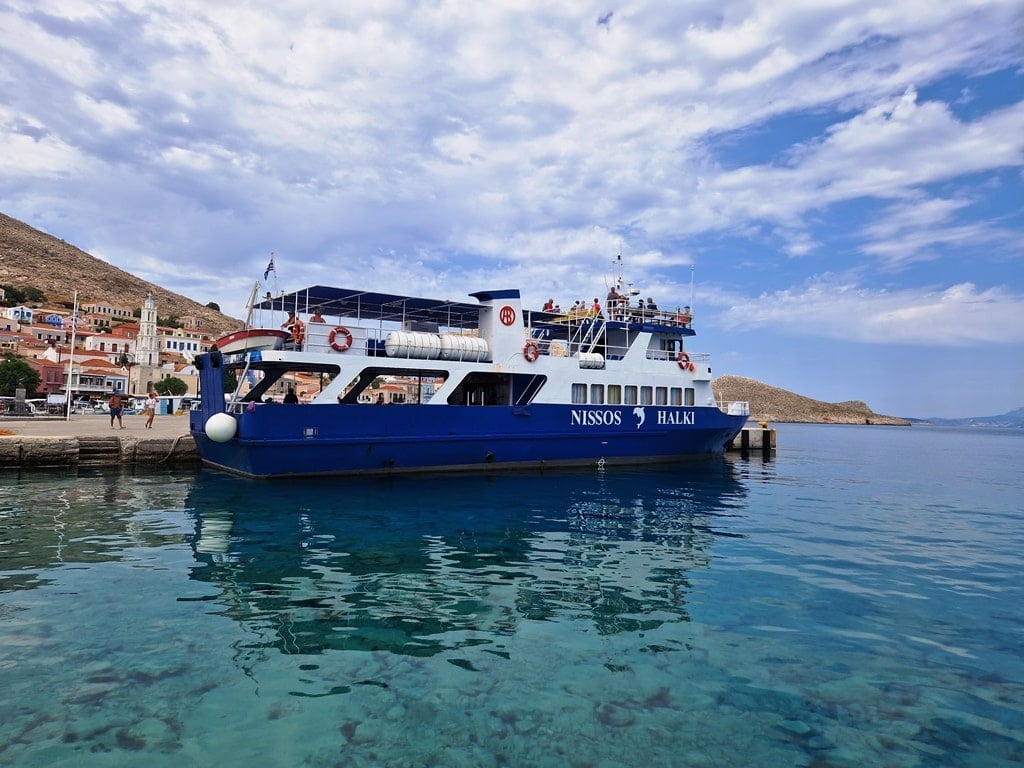
You have a range of options for getting to Halki: you can go either by ferry or a combination of plane and ferry.
If you opt to go by ferry, you can go directly to Halki by taking a ferry from Athens’ main port, Piraeus. Make sure to book a cabin, however, because the trip lasts 20 hours! Alternatively, you can get the ferry from Piraeus to Rhodes first, which lasts 15 hours, and then take a ferry to Halki from Rhodes, which will last only 2 hours.
Still, traveling solely by ferry to Halki is going to be roughly a day’s worth of travel, so consider flying the biggest part of the trip:
You can fly to Rhodes from Athens airport, which is only one hour. After that, take the ferry to Halki and cut your traveling time to just three hours!
Click here for the ferry timetable and to book your tickets.
Or enter your destination below:
A Brief History of Halki
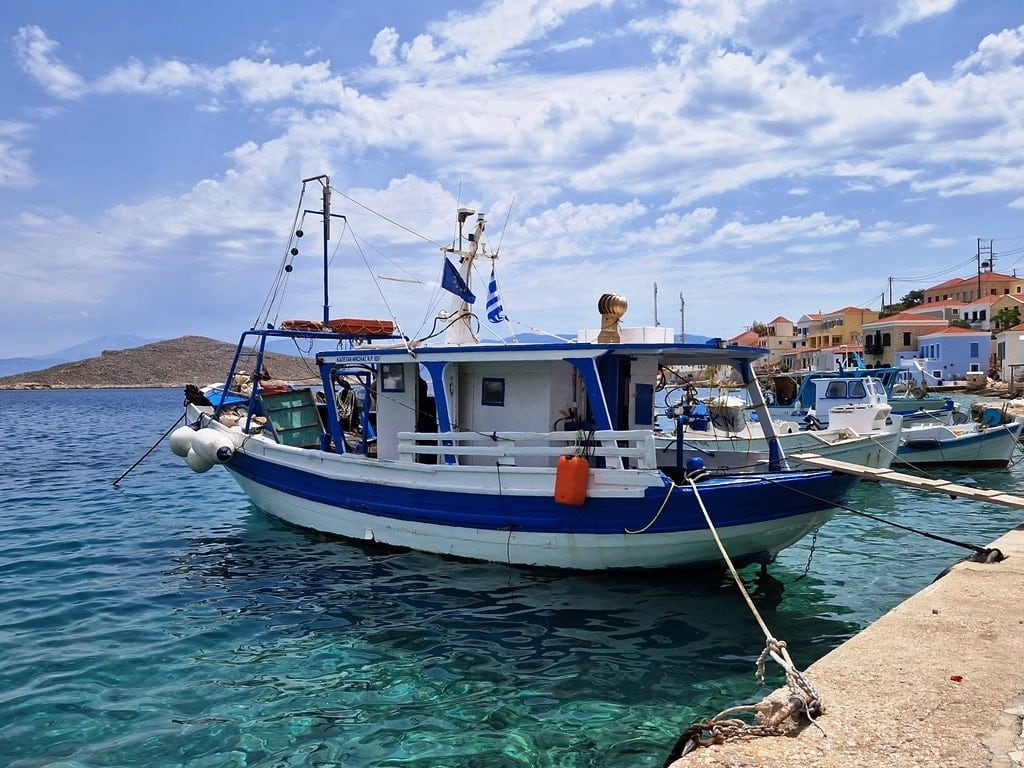
Halki has been inhabited since prehistoric times. According to the legends of ancient Greek mythology, Halki was first inhabited by the Titans, followed by the Pelasgians. One of the first mentions of the island is in Thucydides’ works. Halki was quite autonomous during antiquity and an official ally of Athens.
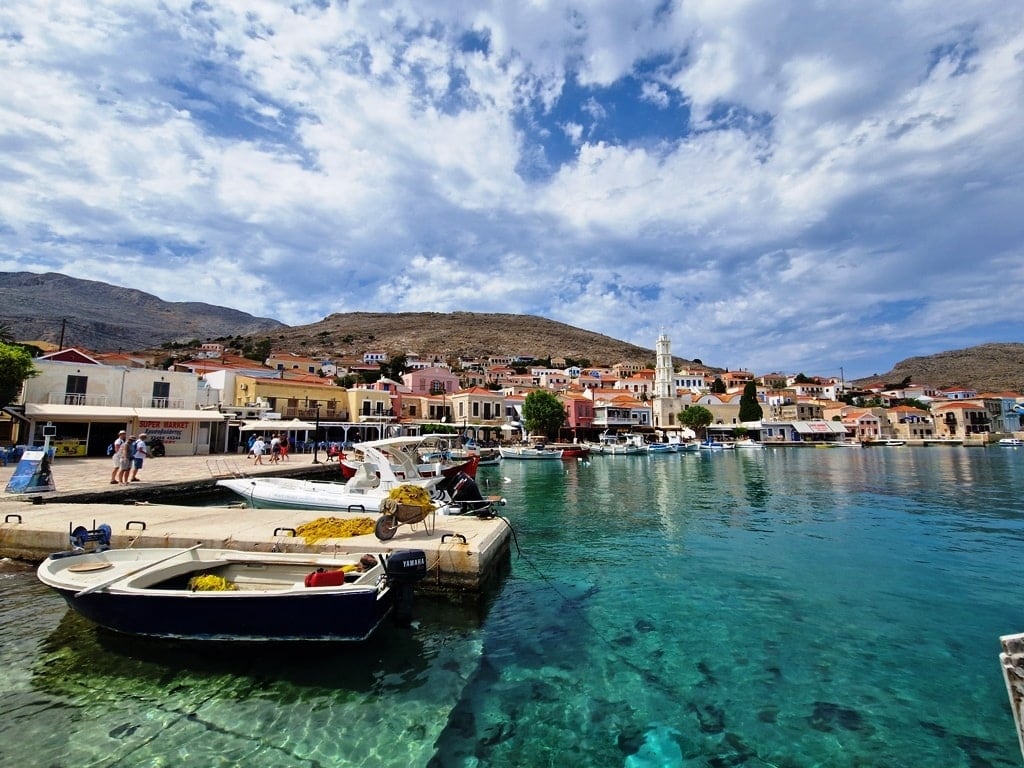
Halki’s history very much parallels that of Rhodes, in being part of Alexander the Great’s influence and later, after the breakup of his empire, formed commercial ties with Egypt and the cities of Asia Minor. After the Romans, the Arabs conquered Halki in the 7th century AD. Then, Venetians and the Genoese took over the island in the 11th century AD. They restored the ancient acropolis and built a fortress at an islet called Alimia.
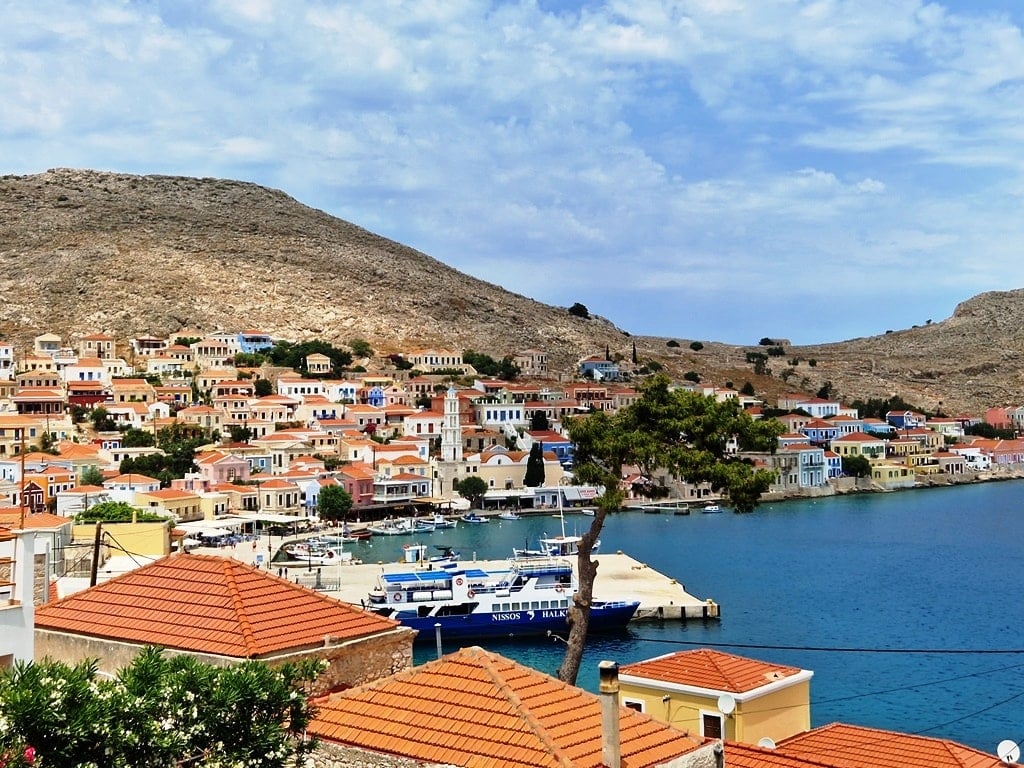
During the 14th century when piracy was a great menace, the Genoese also built a castle that is still standing today, right under the ancient acropolis. Halki fell to the Ottomans in 1523. During the Greek War of Independence, Halki joined the revolution but was controlled by the Italians from 1912 and only joined Greece in 1947 with the rest of the Dodecanese.
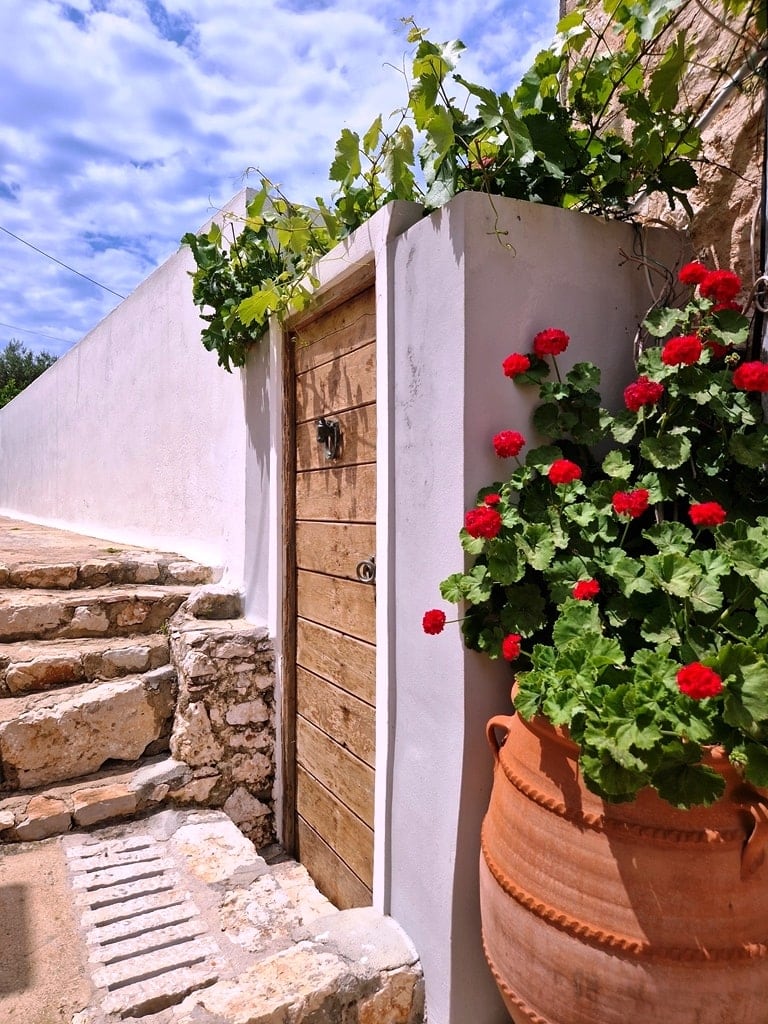
Halki’s main sources of wealth were commerce and sponge diving, which declined dramatically during Italian rule and unfavorable legislation, and the once flourishing island emptied out due to migration.
Things to do in Halki
Despite being so small, Halki has a lot to see and do beyond simply relaxing and recharging. Here are the things you simply shouldn’t miss out on.
Explore Niborio (Emporio)
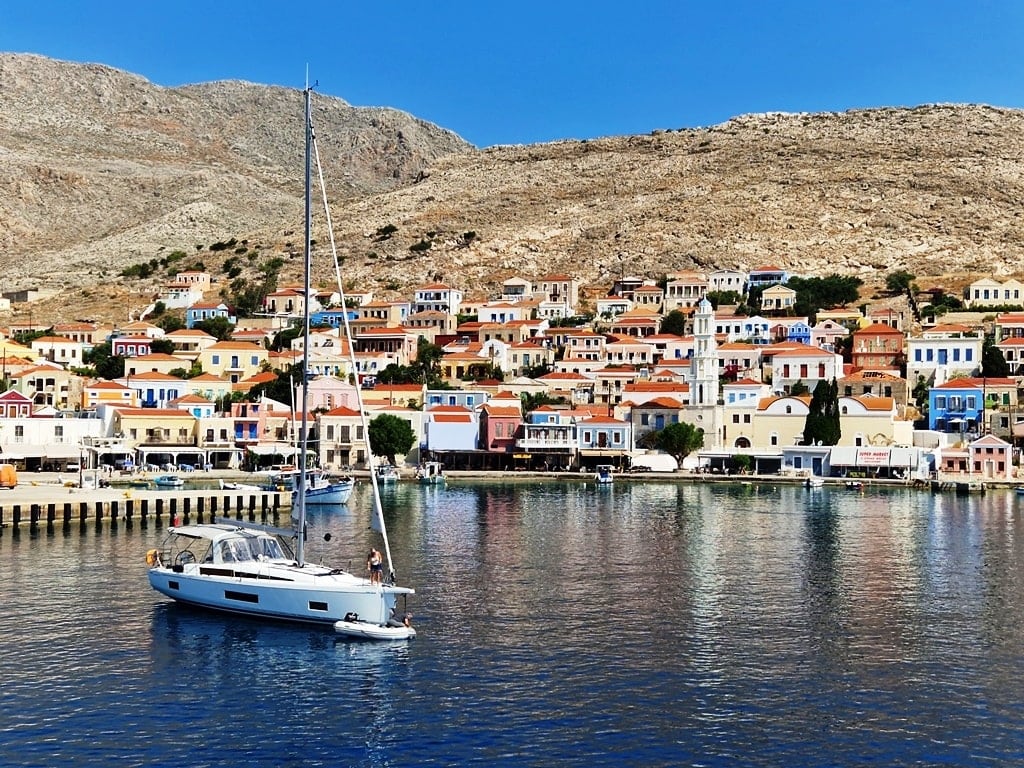
Halki’s Chora is named Niborio (or Emporio). It is the island’s port town and the only one that is currently inhabited. Looking at Niborio is like looking at a painting come alive: neoclassical houses with beautiful, bright colors and crimson roofs, patches of lush nature, and the glistening, crystal-clear waters of the harbor create a tableau that is gorgeous and calm at the same time.
Walk through Niborio’s narrow paths and enjoy the sheer beauty as well as the peace and quiet.
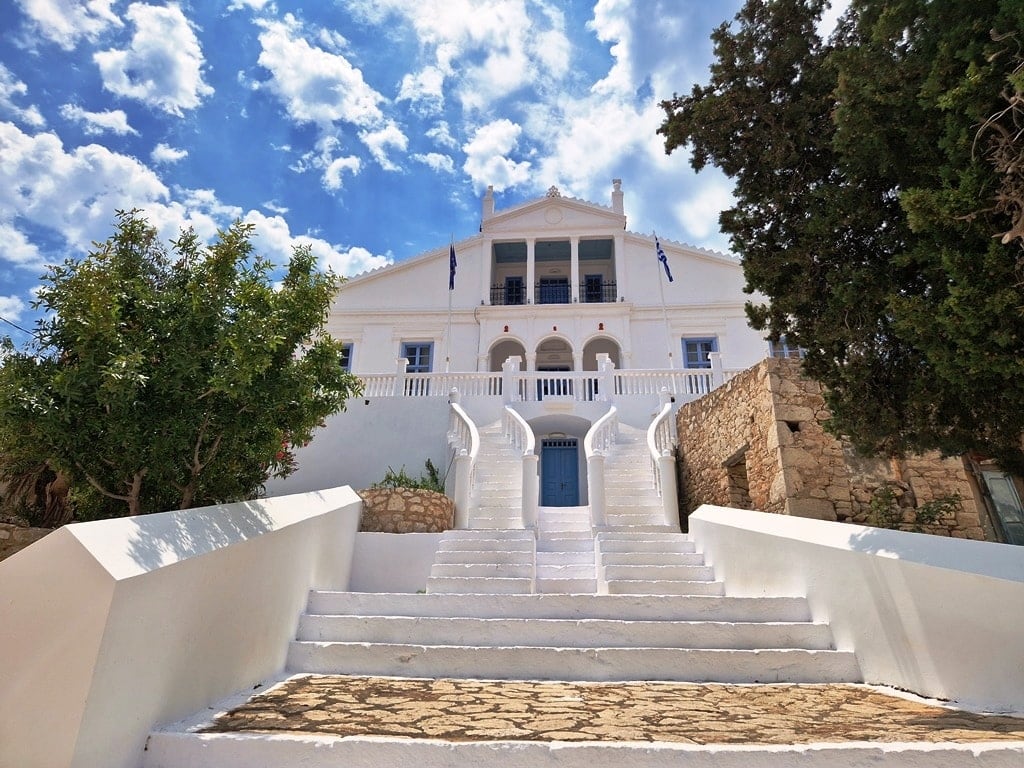
Town Hall: This beautiful sample of island architecture blended with neoclassical elements is Niborio’s gem. It was built in 1933 to serve as a boys’ school but has had several functions over the years. You will find it at the highest point in the village. Go up the winding staircases to enjoy a sweeping view of the bay.
Clock Tower: The Clock Tower of Halki is a remarkable landmark. Situated in front of the Town Hall, it is a tall stone structure with lush decoration and side tiers.
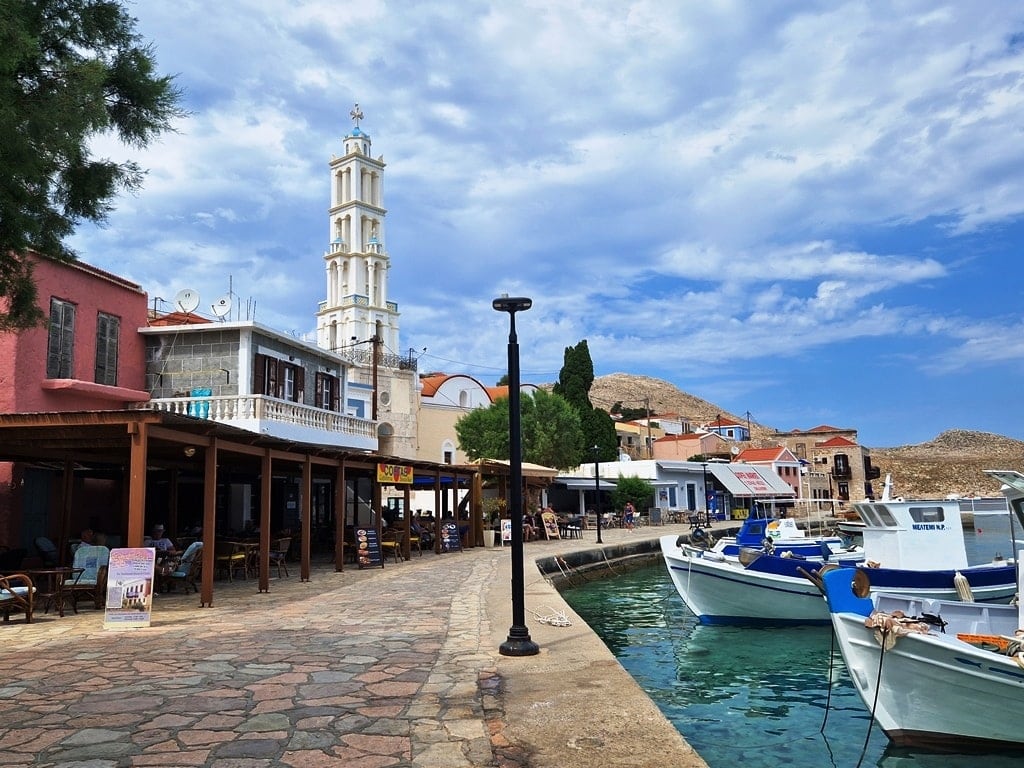
Post Office: Halki’s post office is housed in an iconic building of the island’s Italian rule era.
Windmills: Reigning over the town of Niborio are the windmills of Halki. They are no longer operational but remain a symbol of Halki’s prosperous past. Excellent for breathtaking views.
Visit the museums
Ecclesiastical Museum of Halki: Enjoy an interesting collection of ecclesiastical art from the 18th century to the 20th, both local and international. The collection includes 70 remarkable pieces.
The Traditional House of Halki: Go on a journey to the past by visiting this museum, also called the Museum of Folklore of Halki. Collections include folklore items of everyday life at Halki in the previous centuries, including a wedding bed and folk costumes. There is also a collection of archaeological items.
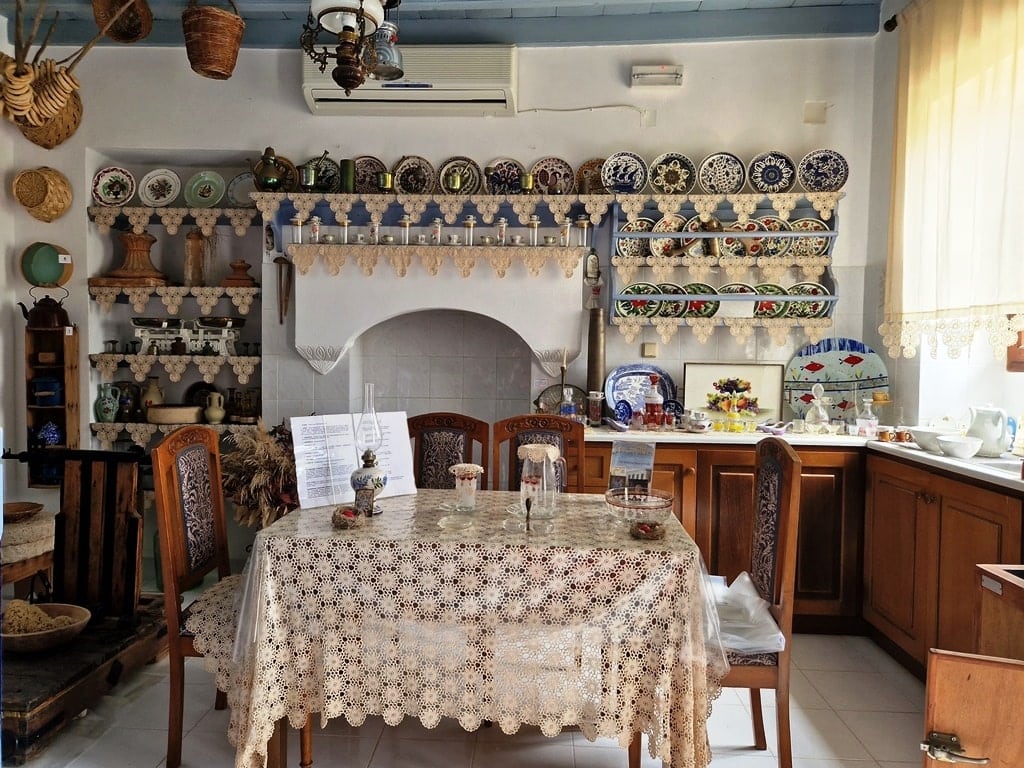
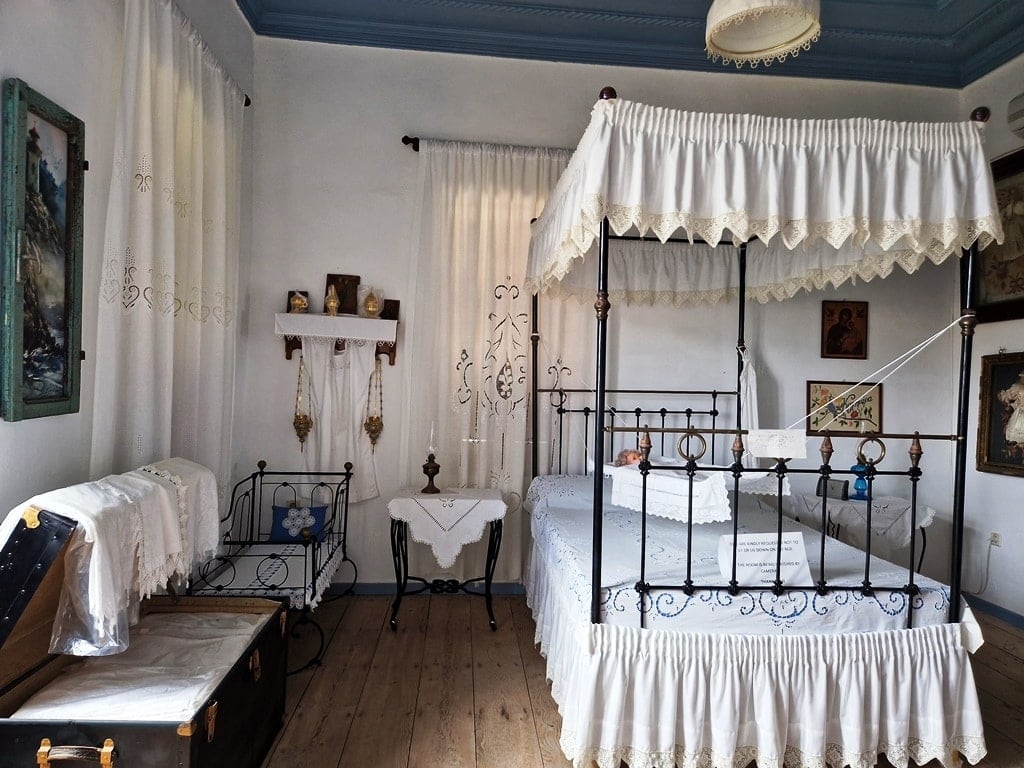
Aghios Nikolaos Church: Aghios Nikolaos is the island’s cathedral, dedicated to Halki’s patron saint. It was built in the mid-19th century. Enjoy the impressive courtyard with the mosaic made of black and white sea pebbles.
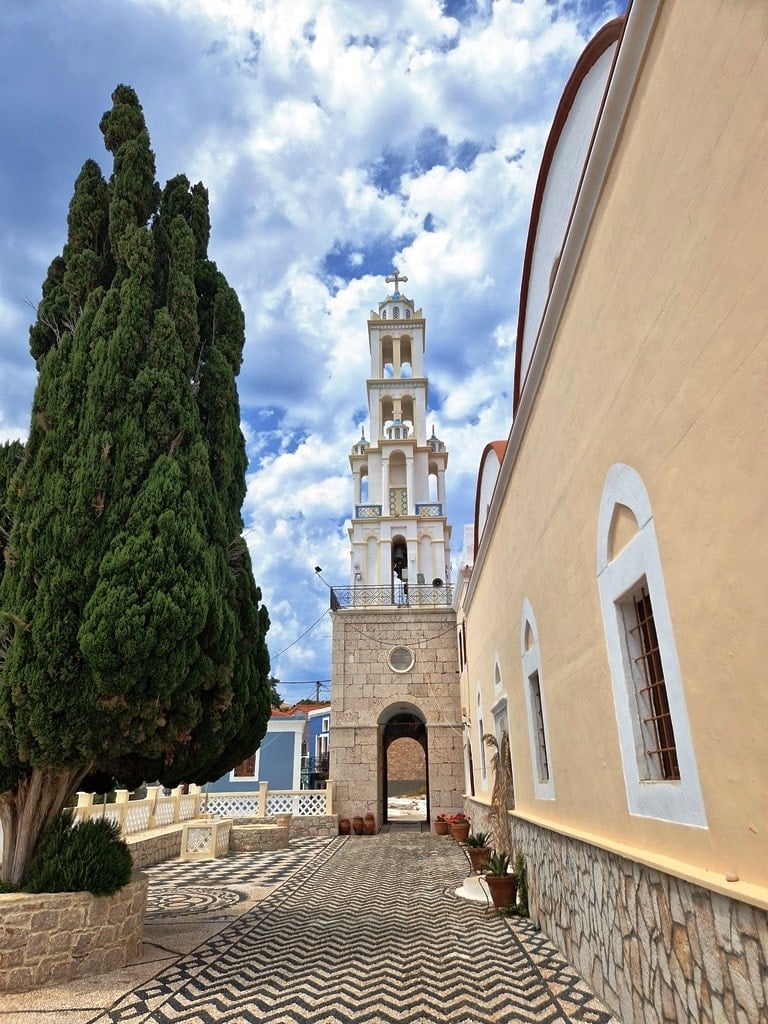
Inside, the highly decorated iconostasis features life-size icons of various saints, including Aghios Nikolaos. The large chandeliers and other decorations were all donated by the faithful, and the steeple is uniquely designed to showcase the various engravings.
Visit Chorio
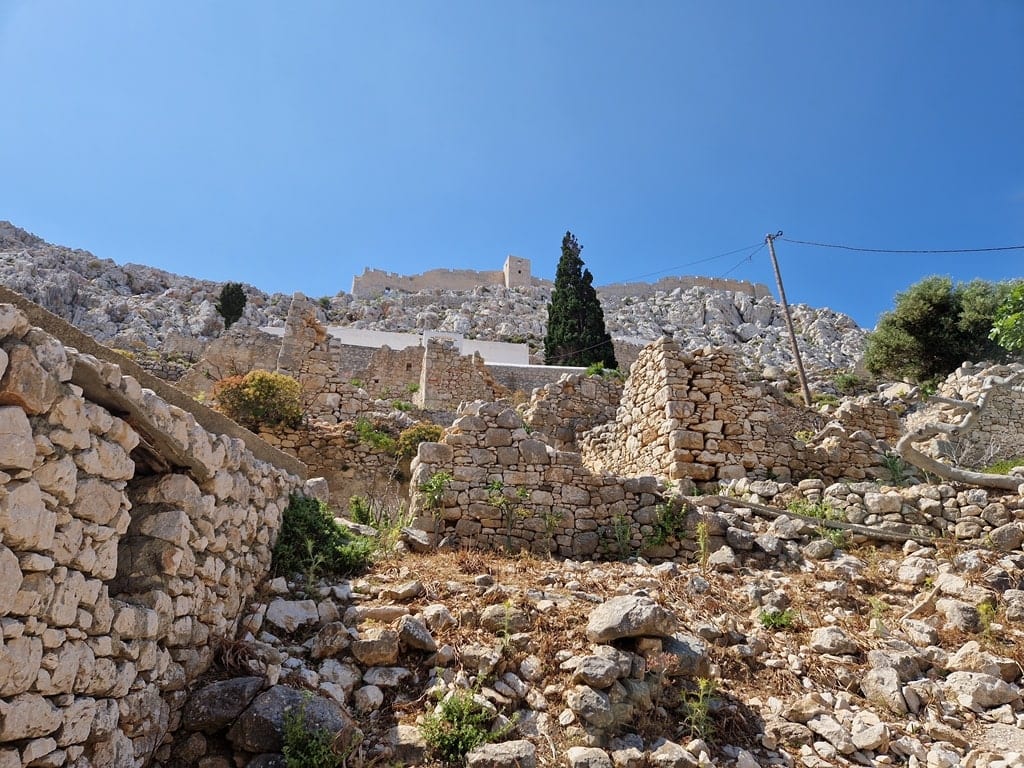
North of Niborio you will find the now-abandoned town of Chorio. Chorio had been Halki’s original Chora and was inhabited up to the middle of the 20th century.
A testament to Halki’s prosperity and powerful history as a naval and commercial node over the millennia, you will see walls dating from a few centuries BC.
You will also see parts of houses, altars to churches, and more constructed with materials from ancient temples and houses from earlier versions of the town.
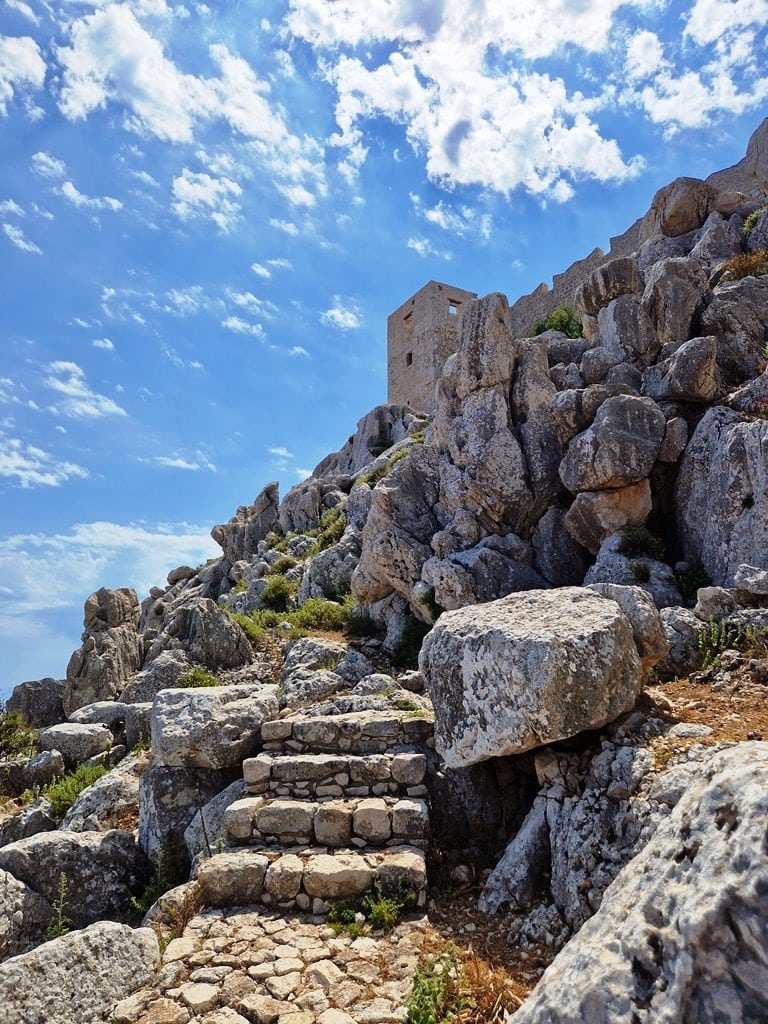
Chorio is in ruins today, except for the Church of the Virgin Mary (Panagia). This church was built in the 1400s and still stands. Make sure you visit it to enjoy the frescoes that are still visible on its walls.
If you are at Halki on August 15th, the Dormition of the Virgin Mary, you will also enjoy the litany and celebrations of the locals that start off at Aghios Nikolaos at Niborio and end up at Chorio’s Panagia.
Visit the Castle (Kastro)
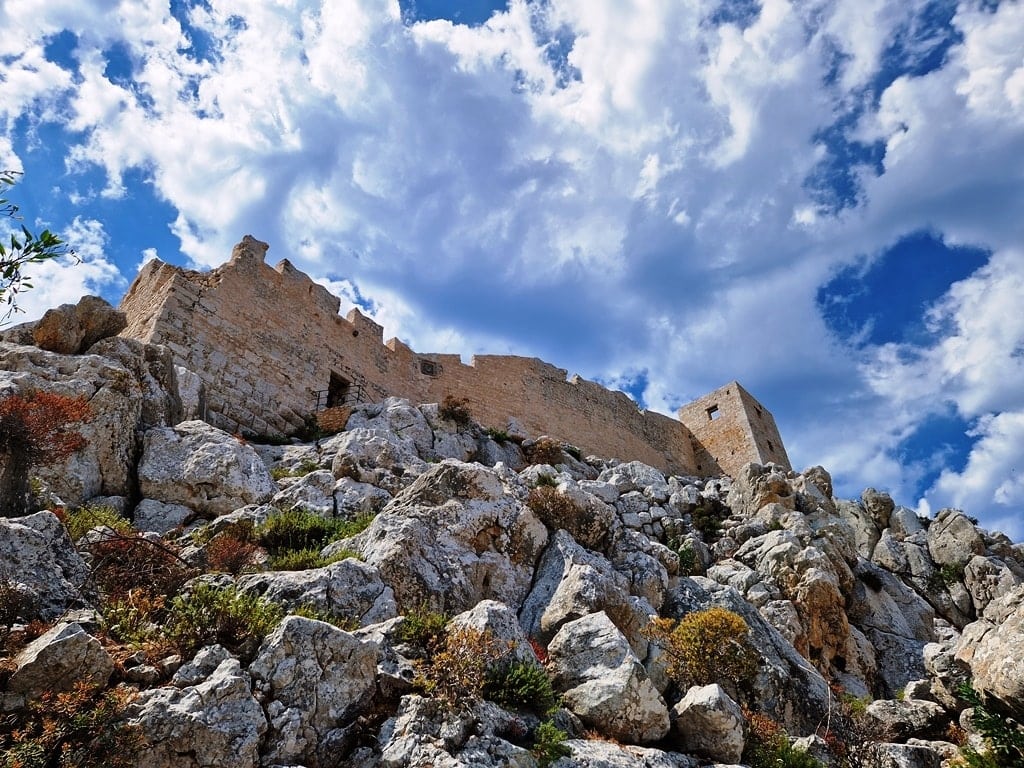
At the top of the slope where Chorio is, you will find Kastro, which means “Castle” in Greek. Kastro was built in the 14th century by the Knights of St. John on the ruins of the ancient Acropolis of Halki.
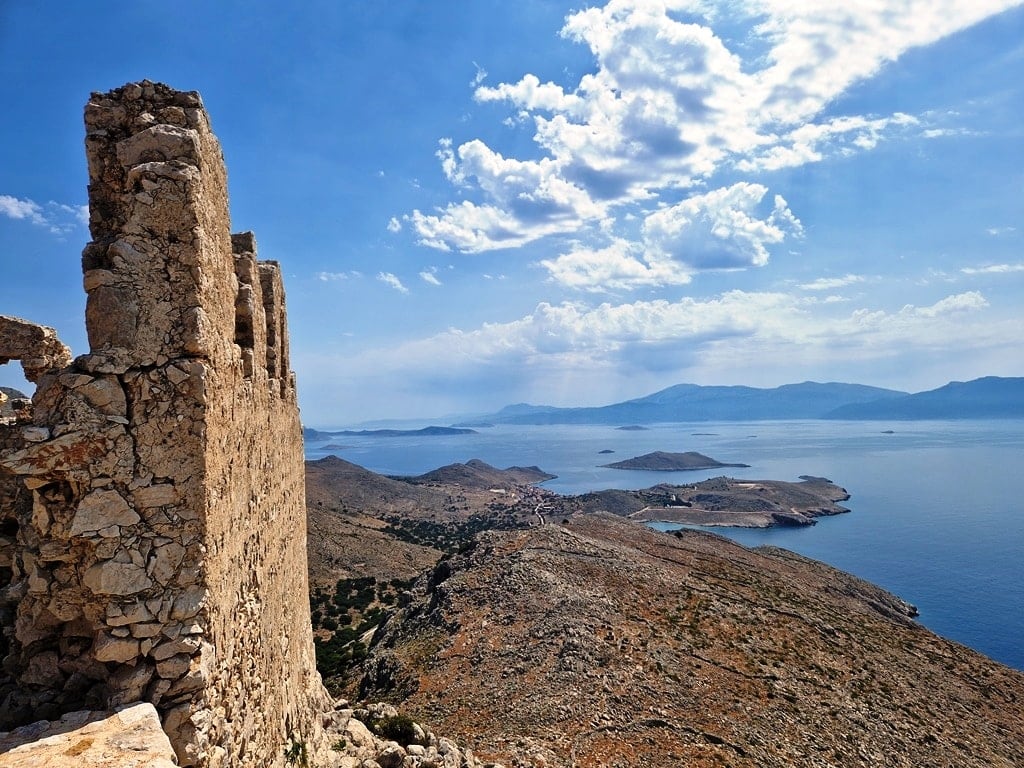
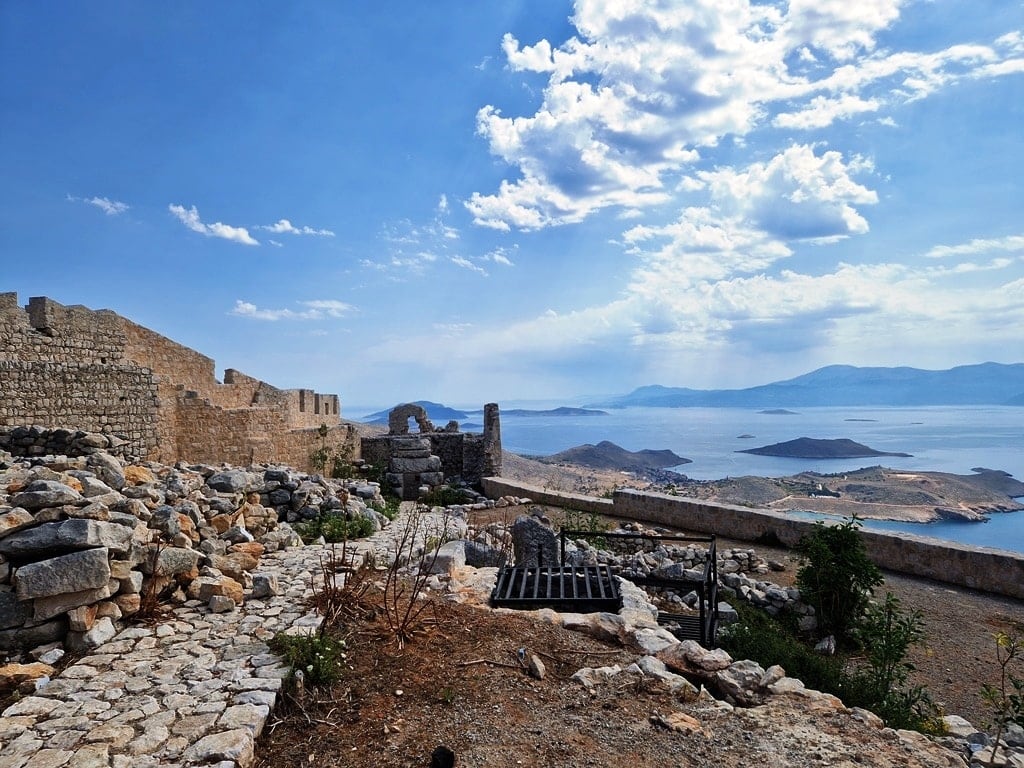
Explore the various paths and look for the crests of prominent knights, including the one of the Great Magistrate. Enjoy the sweeping views of Halki from that vantage point, as well as the little islets that are visible when the day is just right.
Visit the Monastery of Aghios Ioannis Alarga
Located on the western side of Halki, in one of its most remote areas, you will find this beautiful monastery. The views from the plateau where it is built are stunning, but that isn’t all: Relax in its large, tranquil courtyard with the giant cypress tree, and arrange to sleep in one of the cells there for an absolutely unique experience of quiet and calm.
Visit the Monastery of Taxiarhis Michael Panormitis (Panormites)
Near Chorio, you will find this Monastery, with yet more sweeping, beautiful views of the Aegean as well as a large courtyard to relax in. The courtyard and the monastery are typical examples of Dodecanesian art, so make sure you visit.
Hit the beaches in Halki
Halki’s irresistible attraction is its gorgeous beaches. Here are some you must visit:
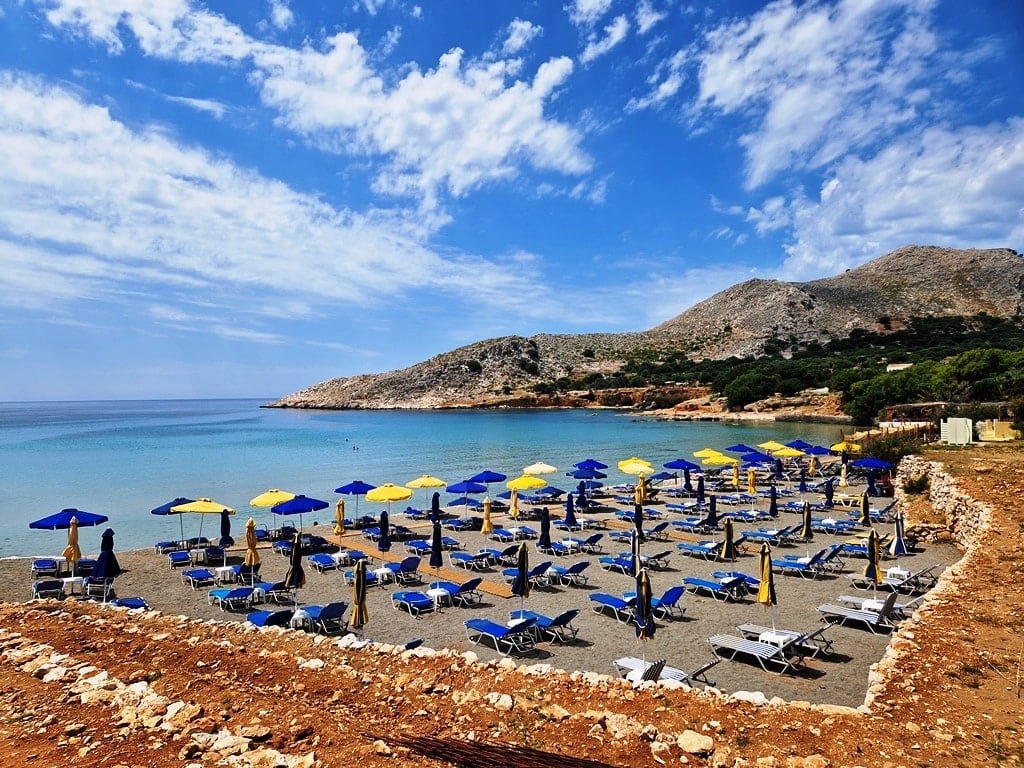
Potamos Beach: Very close to Niborio you will find this beautiful and popular beach. Its crystal clear waters together with the white gold sand and the considerable organization make it an attraction for most.
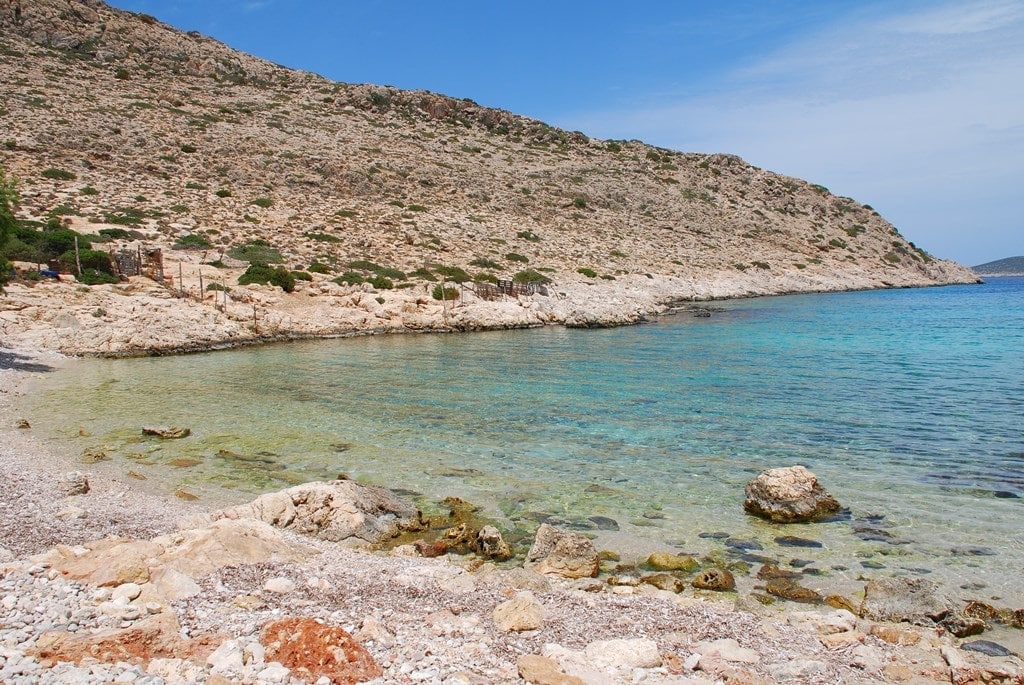
Kania Beach: Kania Beach has a feeling of wild seclusion. With beautiful rock formations yet featuring gold sand, this beach is remarkably beautiful. The waters are turquoise and astoundingly clear. You can access this beach on foot but also by little boat, adding to the experience. There is a taverna on the beach.
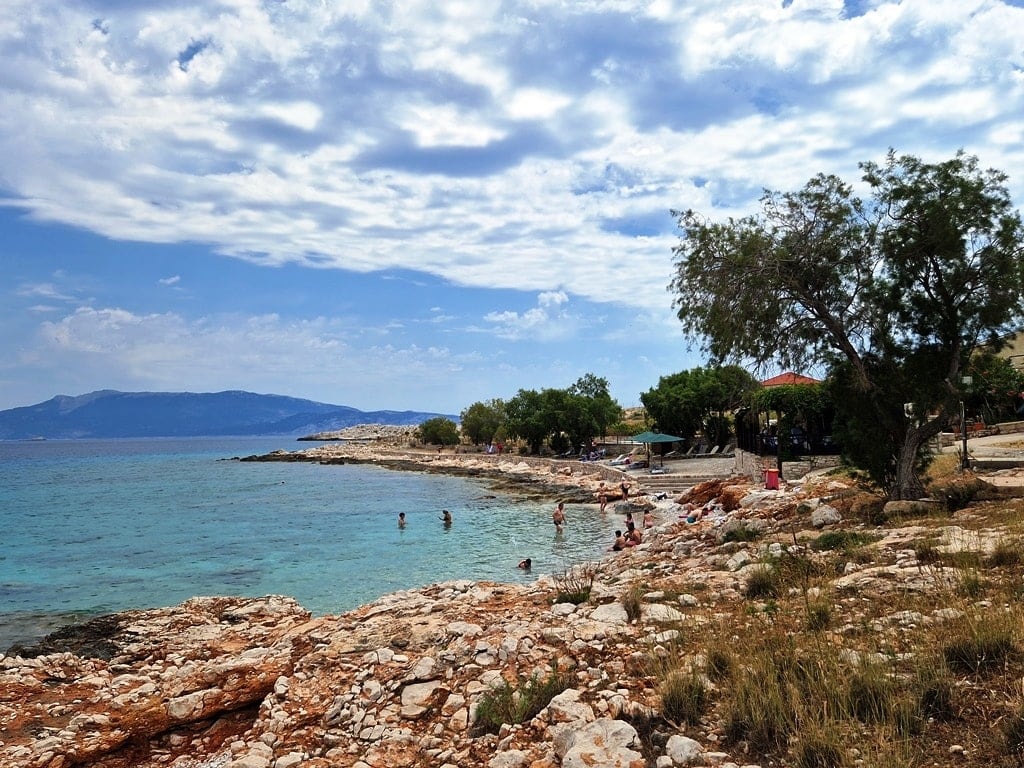
Ftenagia: This little pebbly beach is also quite close to Niborio. Azure waters clash beautifully with the ochre of the shore. The beach is friendly for nudism and generally gives a sense of laid-back acceptance and relaxation.
Areta: You can only access this beach by boat. It is actually two smaller beaches, both pebbly, with emerald waters and stunning, impressive rock formations like cliffsides on either side.
Yali: The sapphire waters of Yali Beach are perfect for total relaxation. The sharp rockface surrounding the pebbly beach gives it a sense of total seclusion and calm as well as beauty.
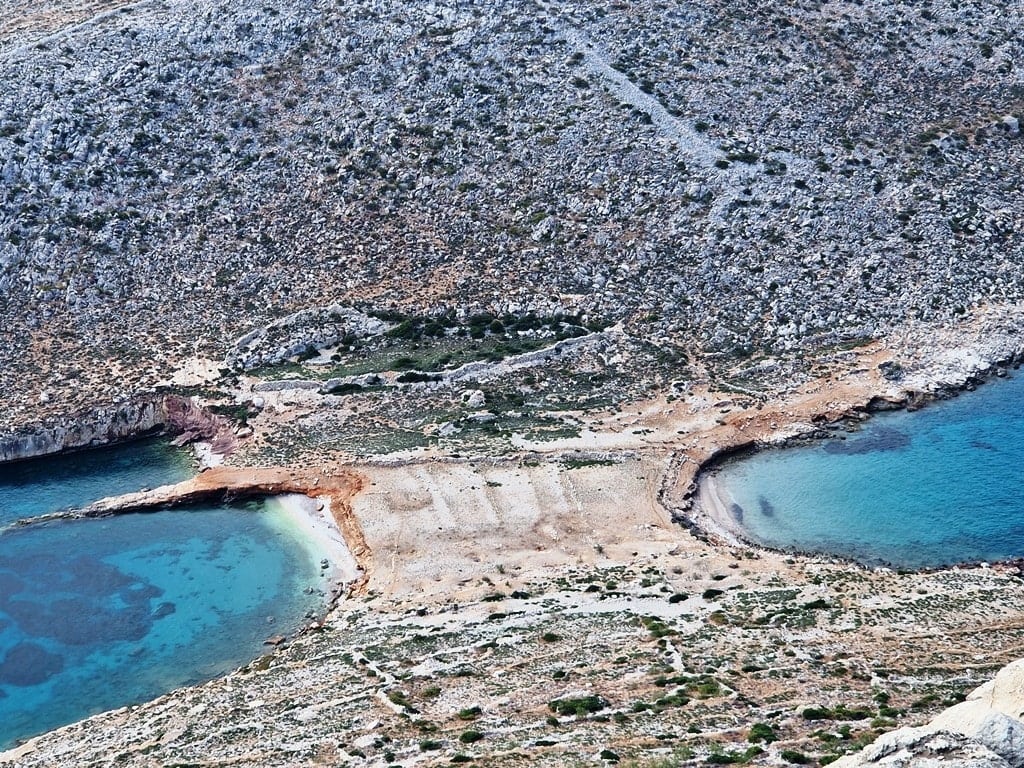
Trahia: This stunning, unique beach is actually a tiny peninsula. The thin strip of land makes the beach double, with water on either side of it. You can reach Trahia only by boat. Make sure you get your own umbrella as there is no shade!
Go hiking
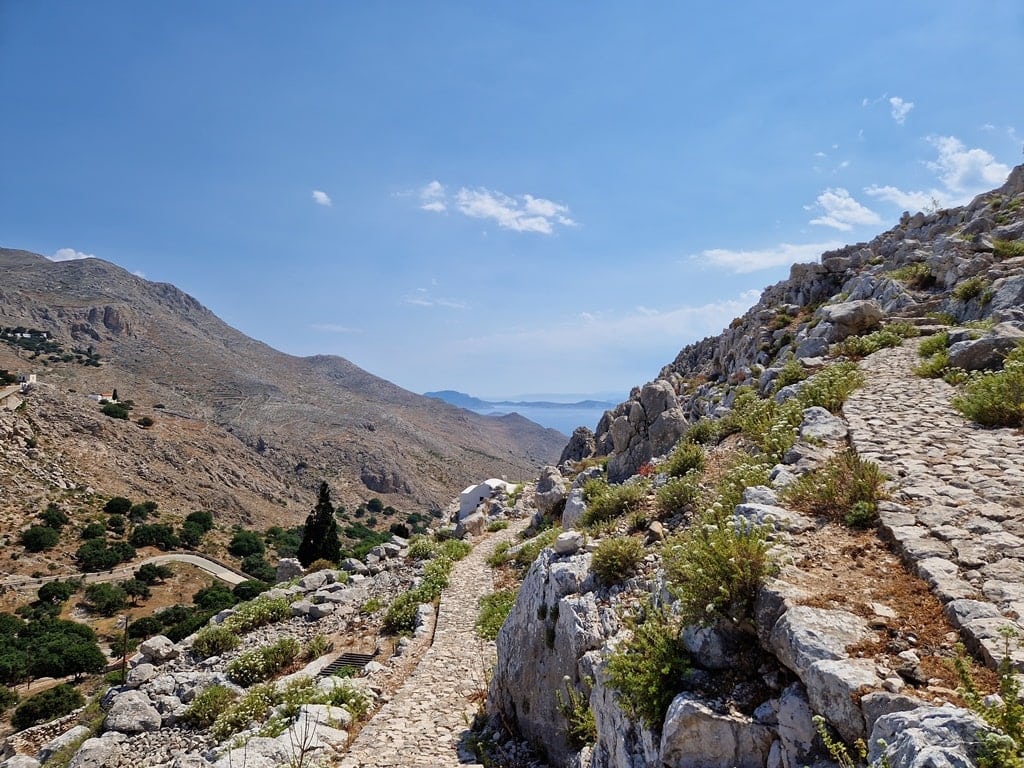
Halki is an ideal place for lovers of hiking. It’s small enough that you can literally go everywhere in Halki on foot. This means that there are several routes with promising views and sites that you can take. Here are some of the best ones:
Chorio and Kastro: Start off from Niborio, taking the old path towards Chorio. Walking on the path you will see beautiful olive groves, sweeping views of the island and the Aegean, and even traditional yards from various houses. Reach Chorio then go through it up the slope to the Castle to treat yourself to the best vantage point on the island.
Aghios Giannis Alarga: Walk through beautiful fig trees and prickly pears on either side of the path, with rosemary, sage, and thyme making the air fragrant. The beautiful views aside, you will pass through old stone settlements and warehouses necessary for herders of older times before you get to the monastery for some well-earned rest and refreshment.
Aghios Georgis: The path of Aghios Georgis is a gorgeous meandering walk through the island’s most beautiful side, in the direction of Chorio. Go past the monastery of Panormites on the same path to eventually reach the cave of Lianoktisma and an old abandoned creamery.
Arry to Kania and Pefkia: This path is a treat for those with a flair for history and antiquity. Going past the schoolhouse and up the path, you will go through the beautiful olive groves of Zies and then down to Arry. Go past the chapel of Aghios Ioannis Theologos and stop at the beach of Kania for a cooling dunking. Then, pass by the ruins of the temple of Apollo before finding Pefkia.
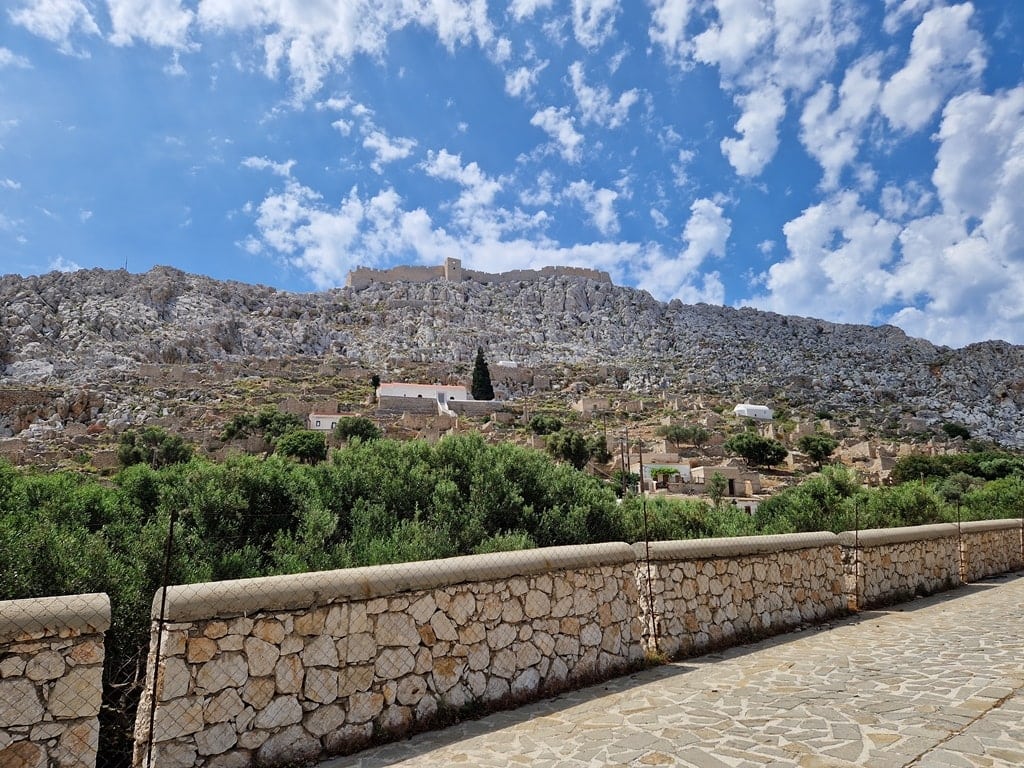
Kammenos Spilios: If you are a fan of adventure, then this hike is for you. Some of the paths aren’t easily seen and you will need to ask for directions or discover them on your own. Start on the path to the chapel of Stavros Ksylou.
As you go past it, look for the turn towards the “Burnt Cave” (that’s what Kammeno Spilio means). Find the historical cave that took its name from a terrible incident in the 15th century: women and children had taken refuge in this unreachable cave to save themselves from Morozini’s wrath.
They had given away Morozini’s fleet’s movements to people at Rhodes. In revenge, Morozini set fire to the forest around the cave, causing the people in it to asphyxiate. If you reach the cave, you can still see traces of the soot from that fire, hence its name “Burnt Cave”.
Pyrgos and Lefkos: This route will reward you with two gorgeous beaches, one at Pyrgos and one at Lefkos. It’s a demanding path that will lead you to the side of the island beyond Aghios Giannis Alarga. You will also see several limpets, a type of butterfly if you walk the path during the right season.
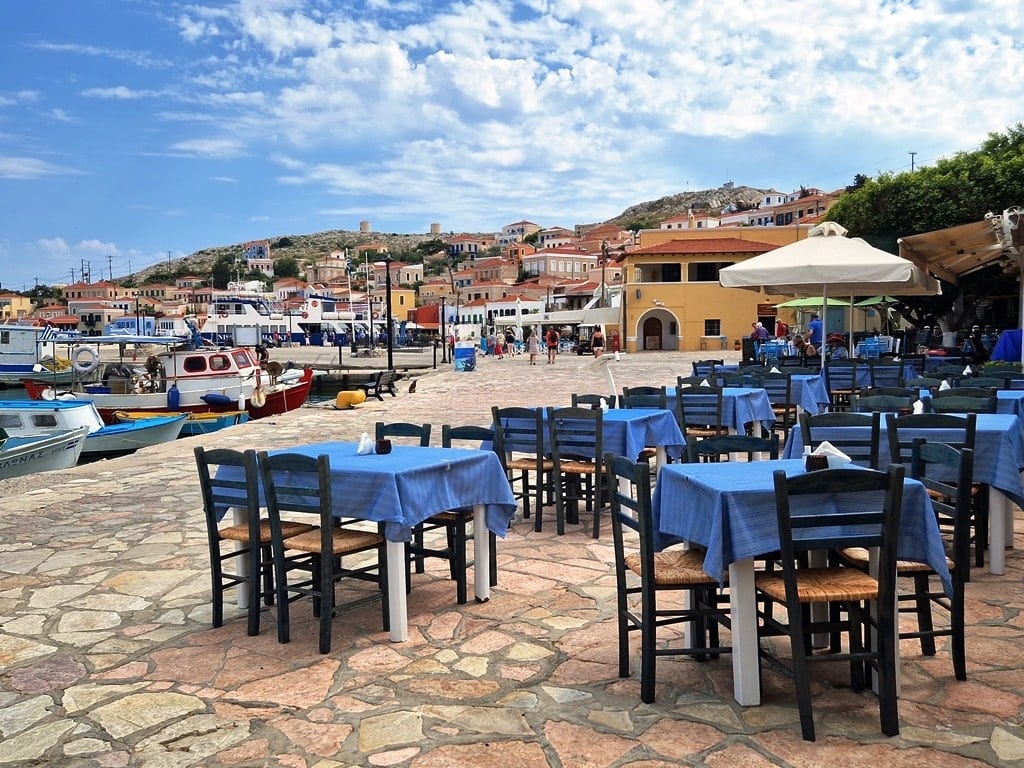
Go scuba diving
Halki has a scuba diving school, so even if you are a beginner don’t miss out on enjoying Halki’s underwater beauty. There are day trips and cruises, snorkeling excursions, dolphin diving activities, and swimming underwater on remote beaches on a regular basis, so don’t miss out on the unique experience!
Getting around Halki
Halki is so small that there is no car needed. There is a bus service and a single taxi available for the places where you don’t feel like walking (though you totally can). Especially for the beaches that are too remote or even unreachable on foot, there is a special bus service and boat service that will take you.
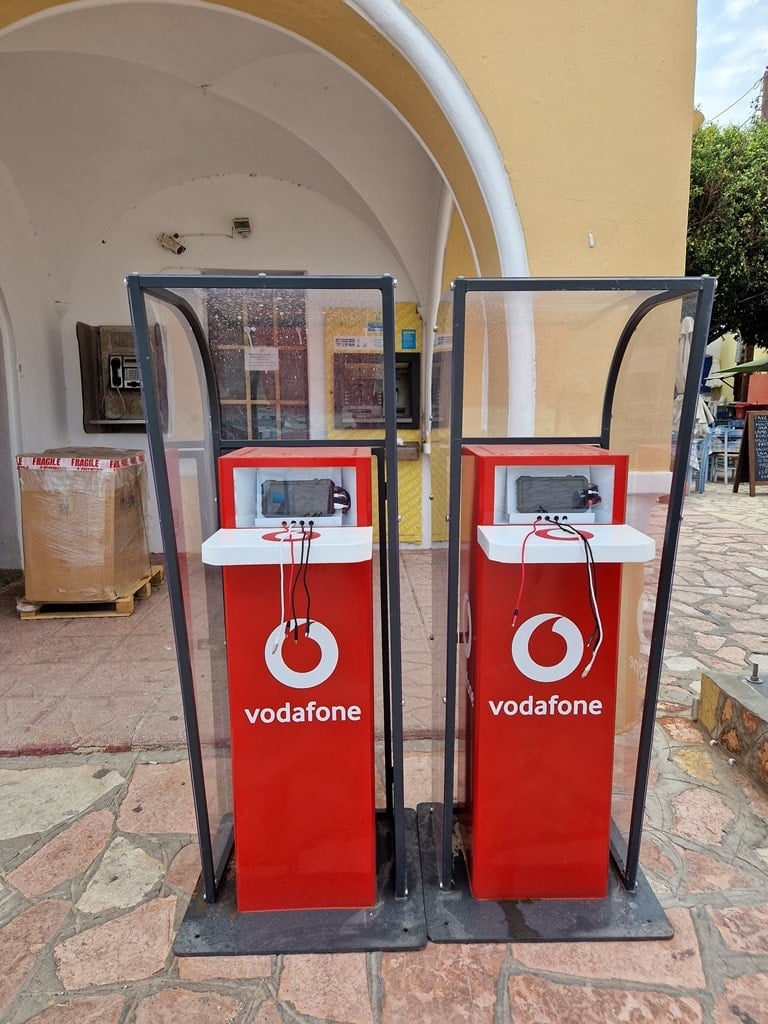
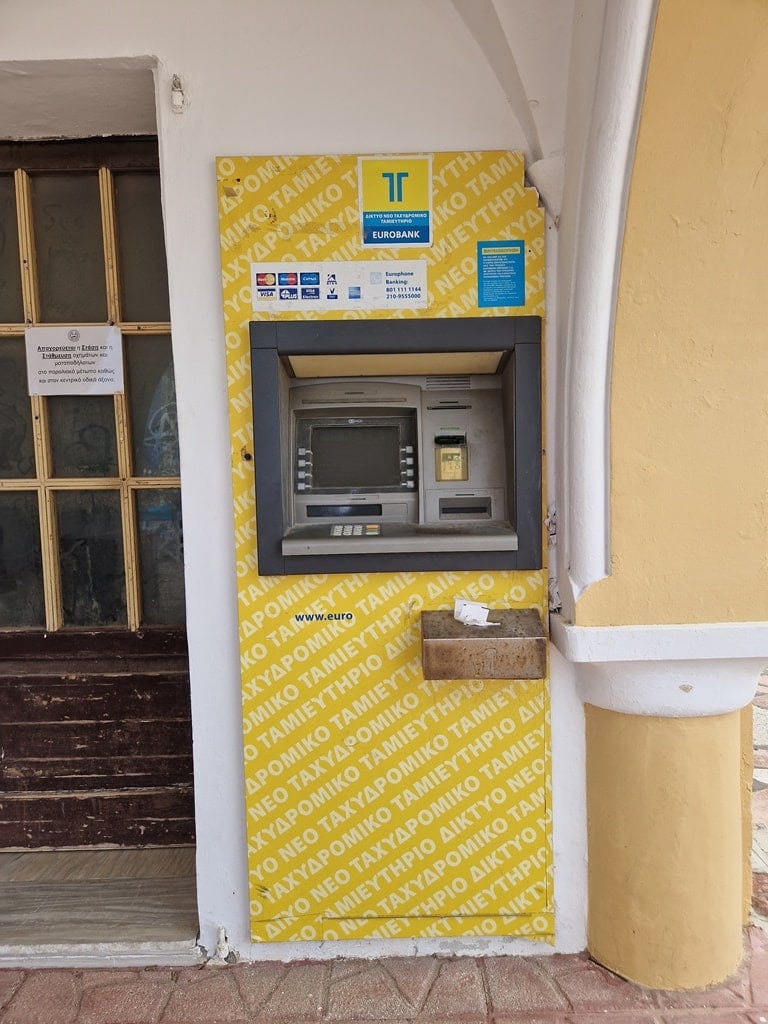
Be aware that there is only one ATM on the island so make sure you carry some cash for emergencies. Beyond that, enjoy the quiet, peace, and relaxation that the lack of cars offers!

